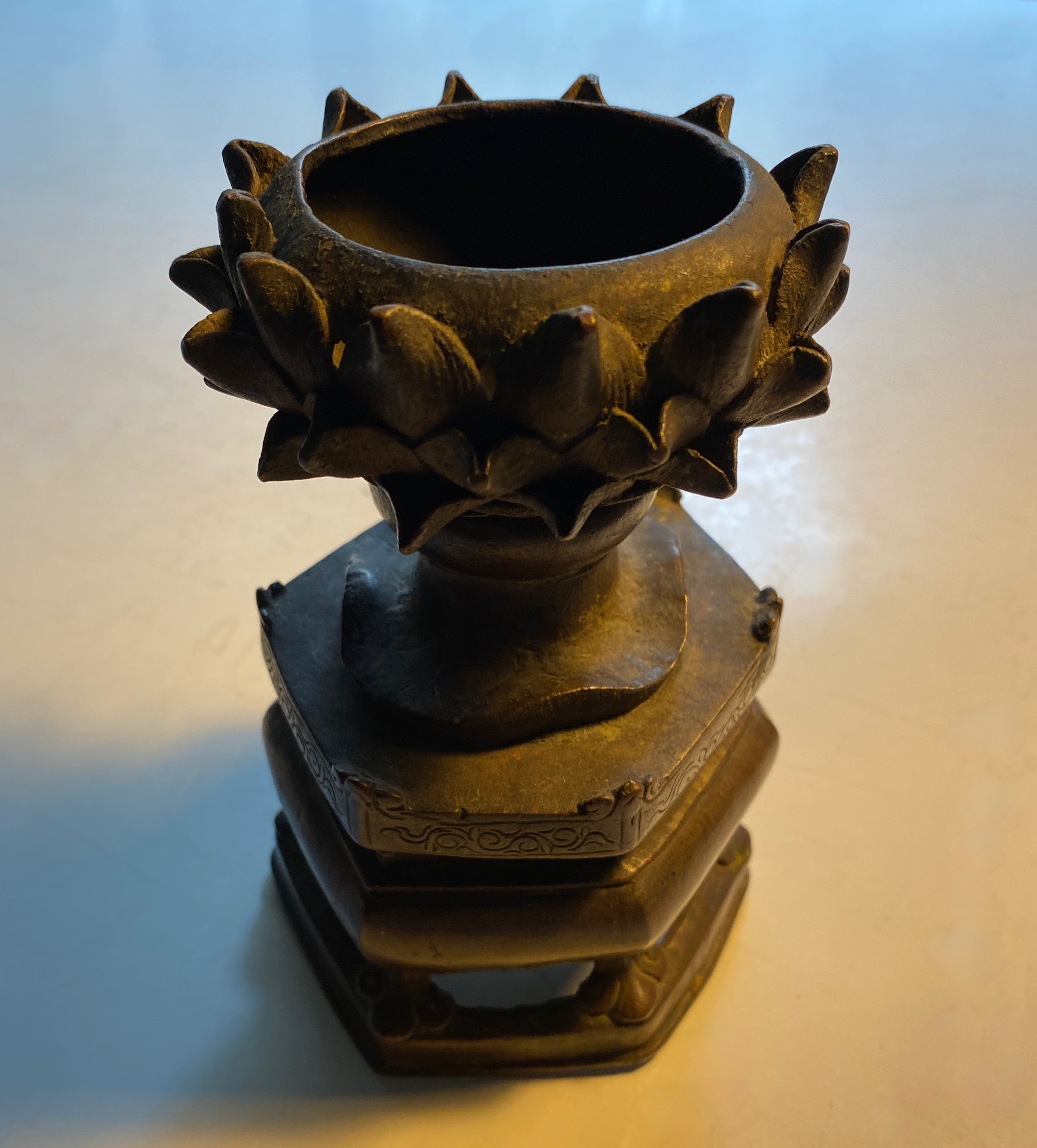

Title: Ancient Artifact Asian Bronze Lotus Sensor Incense Display Stand
Shipping: $29.00
Artist: N/A
Period: Antiquity
History: Art
Origin: Central Asia > China
Condition: N/A
Item Date: N/A
Item ID: 510
A spectacular rare 5th-century ancient artifact: an Asian Chinese bronze lotus sensor incense display stand. The lotus bowl captured the ashes of incense as they fell into and around the ceremonial shrine. The shrines of fifth-century China held great importance in religious and ceremonial practices. These shrines were utilized for various purposes, including worship, offering rituals, and meditation. They were often dedicated to deities or ancestral figures and served as sacred spaces for communication with the divine. Within these shrines, elaborate rituals and ceremonies took place. Incense played a central role, symbolizing purification, offering, and the communication between the mortal and spiritual realms. The incense display stands were specifically designed to hold and release the fragrant smoke of incense, creating an atmosphere conducive to spiritual contemplation and connection. The ashes of the burning incense would fall into a lotus bowl placed on the display stand. This lotus bowl not only captured the ashes but also served as a symbolic representation of purity and enlightenment. The lotus, a revered flower in Chinese culture, symbolized spiritual growth and the transcendence of earthly attachments. Visitors to the shrines would light incense sticks and place them in the designated holders on the display stand. As the incense burned, the smoke would rise, creating an ethereal ambiance and serving as a focal point for prayers, meditation, and reverence. The shrines themselves were adorned with intricate sculptures, carvings, and paintings, often depicting mythological figures, deities, and scenes from religious texts. These artistic elements added to the sacred atmosphere and enhanced the spiritual experience for worshippers.
The history of an ancient Chinese bronze incense display stand, a 5th-century artifact, is deeply rooted in the realm of ceremonial art and sculpture. This object, serving as a shrine, holds significant cultural and historical value. Overall, fifth-century Chinese shrines and their associated incense display stands were integral to religious and ceremonial practices, providing a space for devotion, connection with the divine, and the expression of cultural and spiritual beliefs. The practice of using incense in China has a long and rich history that dates back thousands of years. Incense has played a significant role in Chinese culture, religious rituals, and daily life. The origins of incense usage in China can be traced back to ancient times, with references to its use in historical texts and archaeological discoveries. The Chinese believed that burning incense had the power to ward off evil spirits, purify the environment, and bring good fortune. It was also seen as a means to communicate with the spiritual realm and offer reverence to deities and ancestors. During the Han Dynasty (206 BCE - 220 CE), the popularity of incense continued to grow. It became an integral part of religious ceremonies and offerings. The use of incense was closely associated with Buddhism, which was introduced to China during this period. Buddhist temples and monasteries became centers of incense burning, with large censers placed in prominent locations. The Tang Dynasty (618-907 CE) marked a golden age for incense culture in China. Incense ceremonies and appreciation reached new heights during this period. The imperial court held elaborate incense ceremonies, and the fragrance of incense became highly valued and sought after. The appreciation of incense extended beyond religious rituals and became an art form in itself, with scholars and connoisseurs studying and composing poems and essays on various types of incense. In subsequent dynasties, incense continued to hold cultural and spiritual significance. Incense ceremonies became part of traditional festivals, ancestral worship, and even daily routines in households. Different types of incense were developed, each with its own unique scent and purpose, ranging from medicinal incense to fragrances used for relaxation and meditation. In modern China, the practice of burning incense remains prevalent. It is still used in religious ceremonies, temples, and monasteries, as well as in households for personal rituals and meditation. Additionally, the appreciation of incense as an art form continues, with collectors and enthusiasts valuing antique incense utensils, such as censers, incense burners, and holders. Overall, the history of incense in China is deeply intertwined with its culture, spirituality, and traditions. It has played a vital role in religious practices, art, and daily life, reflecting the deep-rooted connection between humans and the aromatic world of incense.